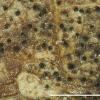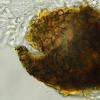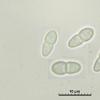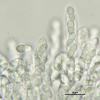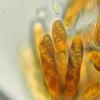
20-06-2022 07:56
Juuso ÄikäsI found some tiny black pyrenos growing on a falle

17-06-2022 20:05
Juuso ÄikäsI found these pale yellow-brown fruitbodies yester

15-06-2022 17:31
Juuso ÄikäsThese little pyrenos were growing on a fallen, dec

15-06-2022 17:50
 Hardware Tony
Hardware Tony
After checking over 40 species of Phaeosphaeria I

11-06-2022 12:03
 Laurent Bonneau
Laurent Bonneau
Adelphella babingtonii Bonjour tout le monde.
Pyrenos on Quercus leaf
Juuso Äikäs,
20-06-2022 07:56
The 2-celled spores measure 8.3 - 9 × 3.5 - 4.1 µm. IKI negative.
Does anyone know what this is? Probably something quite common. Venturiaceae?
Spooren Marco,
20-06-2022 11:35
Re : Pyrenos on Quercus leaf
Hello,
What do you think about "Mycosphserella punctiformis "?If there was no name change there ?
Best,
Marco
Juuso Äikäs,
20-06-2022 13:21
Re : Pyrenos on Quercus leaf
Thanks for the answer -- that does seem like a good suggestion.
The spores are a bit wide with this one, though. But if measured from the septum, the width is 2.7 - 3.2 µm, which might fit better. I'm not sure which measurement style is preferred in this case (center vs. max width).
The spores are a bit wide with this one, though. But if measured from the septum, the width is 2.7 - 3.2 µm, which might fit better. I'm not sure which measurement style is preferred in this case (center vs. max width).
Spooren Marco,
20-06-2022 15:49
Re : Pyrenos on Quercus leaf
Dear,
According to Corlett, annotated list names in Mycosphaerell, your measures are reasonable.There is a study in Mycosphaerella by Andre Aptroot, but I not use that one.
Best,
Marco


